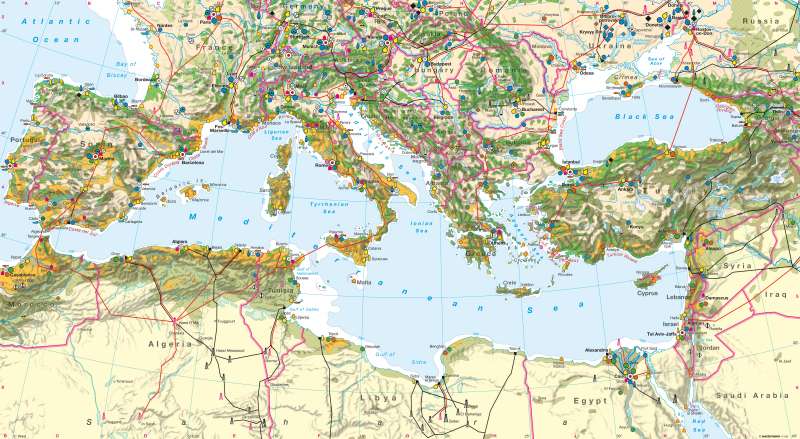Southern Europe — Economy
Southern Europe - Economy
978-3-14-100790-9 | Page 80 | Ill. 1

Information
The Mediterranean has four very different heterogeneous economies: the relatively high cost EU countries, including prolonged crisis transition countries located in Southeast Europe and Cyprus, the Arab countries of West Asia and the developing countries of North Africa. Turkey mediates between the Islamic West Asia and Europe. Israel holds a special position.The EU countries
Some of the economically strongest regions are Portugal, Spain, France, Italy and Greece . However, socio-economic disparities, economic and regional policy debates dominate these regions with a north-south divide especially more notable in Italy.
The commodity potential of southwestern Europe is low, although several industrial areas (such as Northern Spain) owe their origin to mineral resources. This is partly due to where a structural adjustment process is behind the steel industry. The steel plant in Taranto is a typical example of the Italian attempt to give impetus for development using major state industries in southern Italy.
The textile and clothing industry is of continuing importance, which emerged in respect of the value-added share of exports. Due to the high labour costs, Italy and France in particular are forced to remain competitive through high quality. Car production has an important growth and export industry mostly for Italy, France and Spain.
The aerospace industry as a unique high-tech industry has been based in France, Italy and Spain. The Airbus production and EU space programmes have gained a lot in importance, both in the military and private sectors. High-tech fields of electrical engineering and electronics are located primarily in metropolitan areas with their agglomeration advantages (Ile-de-France, Rhône-Alpes, Lombardy).
Because of structural problems, Greece and Portugal, like Spain and Italy, receive significant development assistance from the Regional Fund of the Union. The whole of the coastal area is an important tourist region.
Southeast Europe and Turkey
The countries of this region are in very different socio-economic situations. EU member Greece borders with Albania, which is one of the poorest countries in Europe. Romania — with an external border on the under developed economic region of Moldova — has been included in the EU since 2007. Turkey occupies a mediating position between the "western" EU and the Arab world. There are significant differences within Turkey between the west and east. As well as concentration of large-scale sites on the shores of the Black Sea and the Mediterranean, there are economically un-usable inland regions. However, the development of the coast for tourism is well advanced.
North Africa
The networks of oil and gas pipelines in North Africa and the many examples of mineral deposits, oil refineries and chemical industries on the coast of North Africa, are the primary symbol of importance of these industries for the national economy-mainly for Algeria and Libya, as well as Tunisia and Egypt. These countries already have an economically significant industrialisation from the primary to the consumer goods industry. Tourism plays a major role in countries such as Morocco, Tunisia and Egypt.
A: M. Schrader, E. Thomale, E. Astor; Ü: C. Fleming




